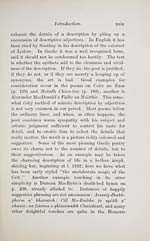Download files
Complete book:
Individual page:
Thumbnail gallery: Grid view | List view

:xxx. Introduction.
Tnanner. Some of these can be traced to no particular
author : they are the common property of a nature-
loving people.
VI.— EXTERNAL INFLUENCES.
How far has modem Gaelic poetry been affected
by external influences? To outsiders, such as the
German scholars, the peculiar interest of the old
Gaelic Hterature is that it represents the thought of a
people who, alone in Westem Europe, were practically
uninfluenced by Latin culture. For us, of course, it
has, or ought to have, the additional and still stronger
interest that we find therein the expression of our own
ancestors. Much of this double interest attaches to
the modem literature also. y It, too, expresses the
• eontent of the minds of our ovm people, and up till
about the end of the eighteenth century it represents
on the whole the old Gaehc tradition and culture, with
Httle foreign admixture. That tradition was common
to Ireland and Scotland till about the time of the
E-eformation ; thereafter the tie between the "sea-
divided Gael" became gradually looser, and Gaehc
Scotland continued the old tradition independently of
Ireland.
In Scotland the Gael came early in contact with
two Teutonic peoples, the Saxons (c. 600 onwards) and
the Norse (800-1266). The traces of Norse influence
in our modem poetry are slight, and are confined to
two points, the presence of Norse loan-words and
references to Norse descent. The loan-words fomi a
vei*y small part of the total Gaehc vocabulary; their
Tnanner. Some of these can be traced to no particular
author : they are the common property of a nature-
loving people.
VI.— EXTERNAL INFLUENCES.
How far has modem Gaelic poetry been affected
by external influences? To outsiders, such as the
German scholars, the peculiar interest of the old
Gaelic Hterature is that it represents the thought of a
people who, alone in Westem Europe, were practically
uninfluenced by Latin culture. For us, of course, it
has, or ought to have, the additional and still stronger
interest that we find therein the expression of our own
ancestors. Much of this double interest attaches to
the modem literature also. y It, too, expresses the
• eontent of the minds of our ovm people, and up till
about the end of the eighteenth century it represents
on the whole the old Gaehc tradition and culture, with
Httle foreign admixture. That tradition was common
to Ireland and Scotland till about the time of the
E-eformation ; thereafter the tie between the "sea-
divided Gael" became gradually looser, and Gaehc
Scotland continued the old tradition independently of
Ireland.
In Scotland the Gael came early in contact with
two Teutonic peoples, the Saxons (c. 600 onwards) and
the Norse (800-1266). The traces of Norse influence
in our modem poetry are slight, and are confined to
two points, the presence of Norse loan-words and
references to Norse descent. The loan-words fomi a
vei*y small part of the total Gaehc vocabulary; their
Set display mode to: Large image | Transcription
Images and transcriptions on this page, including medium image downloads, may be used under the Creative Commons Attribution 4.0 International Licence unless otherwise stated. ![]()
| Early Gaelic Book Collections > Matheson Collection > Bardachd Ghaidhlig > (34) |
|---|
| Permanent URL | https://digital.nls.uk/76422935 |
|---|
| Description | Specimens of Gaelic poetry 1550-1900. |
|---|---|
| Shelfmark | Mat.50 |
| Additional NLS resources: | |
| Attribution and copyright: |
|
| Description | Items from a collection of 170 volumes relating to Gaelic matters. Mainly philological works in the Celtic and some non-Celtic languages. Some books extensively annotated by Angus Matheson, the first Professor of Celtic at Glasgow University. |
|---|
| Description | Selected items from five 'Special and Named Printed Collections'. Includes books in Gaelic and other Celtic languages, works about the Gaels, their languages, literature, culture and history. |
|---|

